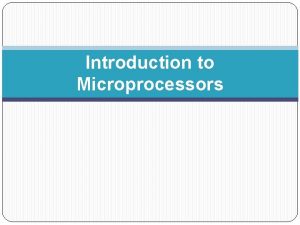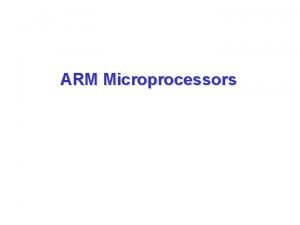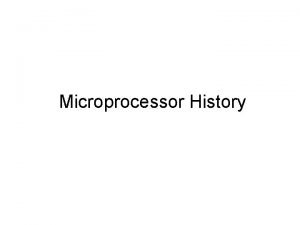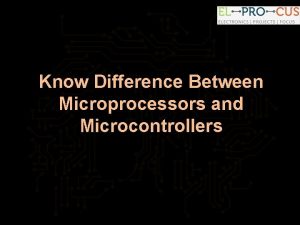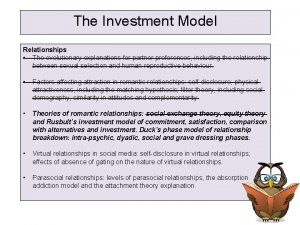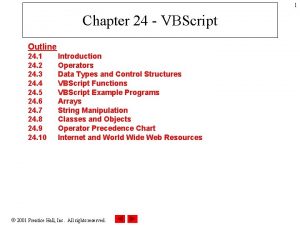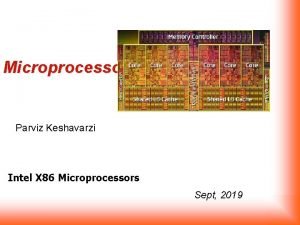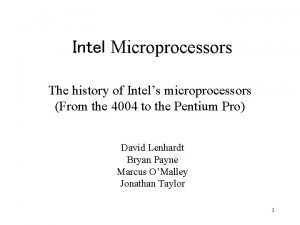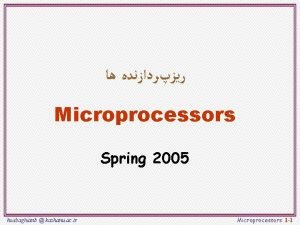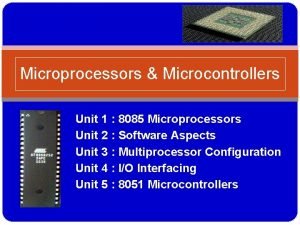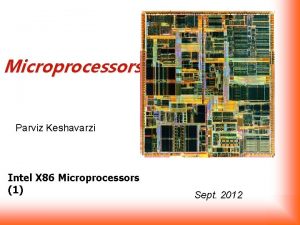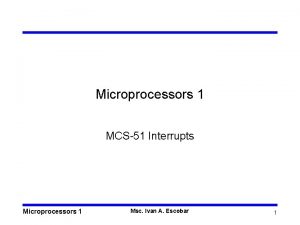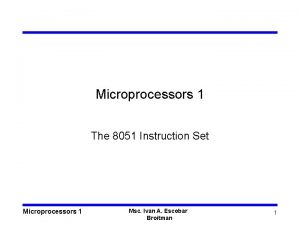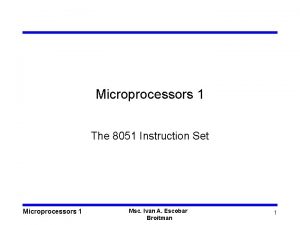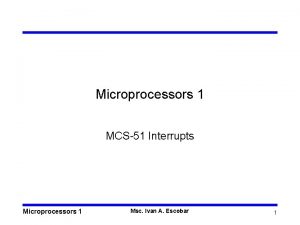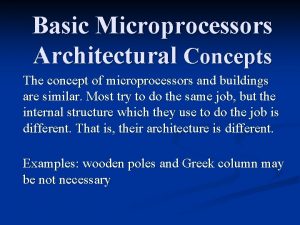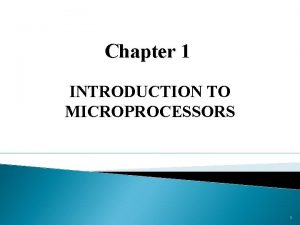Chapter 1 INTRODUCTION TO MICROPROCESSORS 1 Outline Explanation

















- Slides: 17

Chapter 1: INTRODUCTION TO MICROPROCESSORS 1

Outline � Explanation of Terms � Evolution of the. Microprocessor 2

Introduction � The basic blocks of a computer are the central processing unit (CPU), the memory, and the input/output (I/O). � Computer hardware includes such components as memory, CPU, transistors � Computer software consists of a collection of programs that contain instructions and data for performing a specific task. � a translator is necessary to convert such a program into binary and this is achieved using a translator program called a compiler. 3

Introduction � Microprocessor � Both is fabricate a CPU on a single chip metal-oxide semiconductor (MOS) and bipolar technologies are used in the fabrication process. � Along with the microprocessor chip, appropriate memory and I/O chips can be used to design a microcomputer. � Microcontrollers include a microcomputer, timers, and A/D (analog-to- digital) and D/A (digital to analog) converters, all on a single chip. 4

1. 1 Explanation of Terms � An Address is a pattern of 0’s and 1 ’s that represents a specific location in memory or a particular I/O device. Typical 8 -bit microprocessors have 16 address lines, and, these 16 lines can produce unique 16 -bit patterns from 00000000 to 11 11 11 1, representing 65, 536 different address combinations. 5

1. 1 Explanation of Terms � Addressing mode is the manner in which the microprocessor determines the operand (data) and destination addresses during execution of an instruction. � An Arithmetic-logic unit (ALU) is a digital circuit that performs arithmetic and logic operations on two n-bit digital words. � Bit is an abbreviation for the term binary digit. A binary digit can have only two values, which are represented by the symbols 0 and 1, 6

1. 1 Explanation of Terms � Bit size refers to the number of bits that can be processed simultaneously by the basic arithmetic circuits of a microprocessor. A number of bits taken as a group in this manner is called a word. For example, a 32 bit microprocessor can process a 32 -bit word. An 8 -bit word is referred to as a byte , and a 4 -bit word is known as a nibble. 7

1. 1 Explanation of Terms �A bus consists of a number of conductors (wires) organized to provide a means of communication among different elements in a microprocessor system. � Cache Memory is a high-speed, directly accessible, relatively small, semiconductor read/write memory block used to store data/instructions that the microprocessor may need in the immediate future. 8

1. 1 Explanation of Terms instruction set of a microprocessor is a list of commands that the microprocessor is � The designed to execute. � Pipelining is a technique that overlaps instruction fetch (instruction read) with execution. 9

1. 3 Evolution of the. Microprocessor � The Intel Corporation is generally acknowledged as the company that introduced the first microprocessor successfully into the marketplace. � The 4004 is the first processor, was introduced in 197 1 and evolved from a development effort while making a calculator chip set � In 1973, second-generation microprocessors (8 -bit microprocessors) such as the Motorola 6800 and the Intel 8080 10

1. 3 Evolution of the. Microprocessor �A third generation microprocessor (16 -bit microprocessors)introduced in 1978 is typically represented by the Intel 8086 and the Motorola 68000, which are 16 -bit microprocessors. � During the 1980’s, fourth-generation(32 -bit microprocessor, � Since 1985, more 32 -bit microprocessors have been introduced. These include Motorola’s 68020, 68030, 68040, 68060, Power. PC, Intel’s 80386, 80486, the Intel Pentium family, Core Duo, and Core 2 Duo microprocessors. . 11

1. 3 Evolution of the. Microprocessor � The original Pentium processor was introduced by Intel in 1993, and the name was changed from 80586 to Pentium because of copyright laws. � latest speed of 233 MHz. 12

13

14

1. 3 Evolution of the. Microprocessor � Pentium II It basically takes attributes of the Pentium Pro processor plus the capabilities of MMX technology to yield processor speeds of 333, 300, 266, and 233 MHz. � MMX (matrix math extensions)is intended for efficient multimedia and communications operations. � The Intel Celeron processor speed up to 333 MHz 15

1. 3 Evolution of the. Microprocessor � The Pentium III operates at 450 MHz and 500 MHz. � The Pentium IIII currently available at 1. 30, 1. 40, 1. 50, and 1. 70 GHz. � Intel introduced the 32 -bit Pentium M microprocessor in 2003. It was designed specifically for the mobile computing market. � In 2006, Intel introduced the 64 -bit Core Duo microprocessor that ran at a speed of 1. 66 to 2. 33 GHz. 16

1. 3 Evolution of the. Microprocessor � The original Core 2 Duo ran at a speed of 1. 86 to 2. 93 GHz. 17
 Introduction to microprocessors
Introduction to microprocessors Asr instruction in arm
Asr instruction in arm Early microprocessors
Early microprocessors Difference between i c $ microprocessors
Difference between i c $ microprocessors Outline one psychological explanation of schizophrenia
Outline one psychological explanation of schizophrenia Investment model of relationships
Investment model of relationships The quote sandwich example
The quote sandwich example Conclusion paragraph outline
Conclusion paragraph outline 5 paragraph essay
5 paragraph essay Introduction to software engineering course outline
Introduction to software engineering course outline Discourage criminal acts by threatening punishment
Discourage criminal acts by threatening punishment Romans outline by chapter
Romans outline by chapter Elements of research proposal
Elements of research proposal Give me liberty ch 27
Give me liberty ch 27 Methodology chapter outline
Methodology chapter outline Chapter 38 a world without borders outline
Chapter 38 a world without borders outline 24 chapter outline
24 chapter outline Chapter 23 hunger games questions
Chapter 23 hunger games questions
